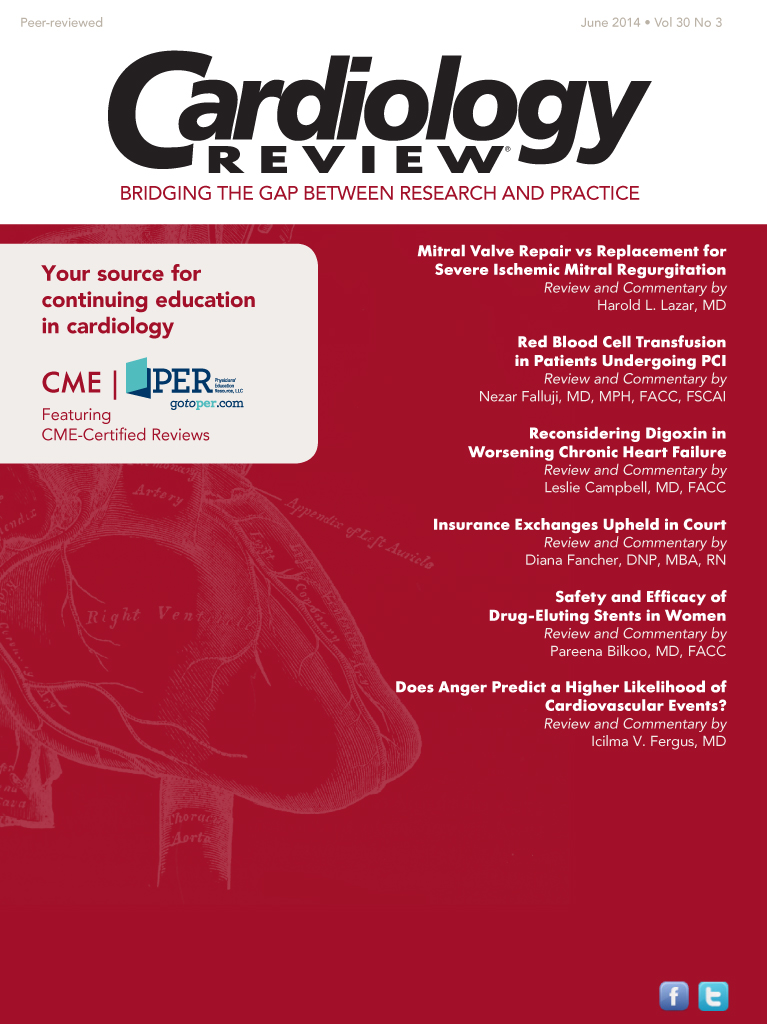Transitioning to Summer With Cardiology Review
In this issue of Cardiology Review, we cover several burning topics of interest to clinicians.

Debabrata Mukherjee, MD, MS, FACC
Editor-in-Chief
T
he hot summer days are upon us and in this issue of Cardiology Review we cover several burning topics of interest to clinicians. Dr. Pareena Bilkoo discusses the safety and efficacy of drug-eluting stents (DESs) in women and opines that although drug-eluting stents have become the standard of care for coronary artery disease, prospective data on the safety and efficacy of DESs in women are lacking because women are underrepresented in stent trials, making up only a small proportion of study participants. Based on the analysis by Stefanini et al, Dr. Bilkoo reassures us that the results in women with DES are consistent with those for men and ap- pear equally effective. She does point out the need for additional pro- spective studies to assess the safety and efficacy of DESs in women.
Dr. Leslie Campbell reviews and reassesses the role of digoxin in heart failure and concludes that rather than focus on a somewhat archaic medication that has little prospective evidence to support its widespread use, she would favor exploring new sensor and computer technologies to monitor high-risk patients at home to prevent readmissions. She further states that digoxin should be a “last DIG effort” in heart failure treatment.
Dr. Nezar Falluji discusses the role of red blood cell transfusion in patients undergoing percutaneous coronary interventions. He concludes that available data highlight the need for randomized controlled trials to help delineate the appropriate use of blood trans- fusion in patients undergoing percutaneous coronary interventions. Blood transfusion is expensive and is associated with the risk of blood-borne infections and other adverse effects, and pending more definitive data, most experts and guidelines recommend a restrictive transfusion strategy taking into account the clinical assessment of the patient (rather than an absolute hemoglobin or hematocrit value) to guide the decision regarding blood transfusion.
Dr. Harold Lazar examines mitral valve repair versus replacement for severe ischemic mitral regurgitation and reports that de- spite correction of mitral regurgitation, patients with ischemic mitral regurgitation still have a poor long-term prognosis. Mitral valve replacement is a more reliable technique to limit recurrent mitral regurgitation but does not improve survival or reverse adverse ventricular remodeling after 1 year. Furthermore, simple ring annuloplasty is not sufficient to alleviate mitral regurgitation when there are changes in both the annulus and the subchordal apparatus.
Dr. Icilma Fergus reflects on whether anger predicts a higher likelihood of cardiovascular events and states that data suggest that within the 2 hours following an anger outburst there is a higher risk of heart attacks, ischemic and hemorrhagic stroke, as well as arrhythmia. She thinks that the meta-analysis by Motofsky et al is a helpful guide in characterizing additional risk categories when assessing pa- tients prone to cardiovascular events.
Dr. Diana Fancher discusses a very hot topic: the validity of health care insurance exchanges that are mandated by the Affordable Care Act (ACA). She points out that considering that the intent of the ACA’s proponents was to increase access to health insurance by the nation’s uninsured, a successful argument against individual subsidies for the federally run exchanges would potentially have great impact on the concept of social justice. The very people the ACA was designed to assist would be left, once again, without the ability to pay for or access health care.
In our diabetes section, Dr. Aparna Bhagavat addresses childhood obesity in the United States, and notes that the enormous burden of childhood obesity has its impact not only in adulthood but also leads to numerous health and psychosocial problems in childhood. She further reflects that it is primarily the responsibility of parents, teachers, and health care professionals to be role models for the younger generation with respect to healthy eating and physical activity. The key to solving this problem is to continue to promote education through research, publications, and public media. Finally, Jackie Syrop (our excellent managing editor), has put together a succinct summary of several key clinical trials presented at the American Society of Hypertension meeting and key news items, which I am sure you will find to be useful reading.
I hope that you will find these commentaries to be valuable and enjoyable. I encourage you to share your insights, thoughts, and personal experiences on the topics touched upon in this issue. On a broader level, I would love to hear feedback on how we can make this journal even better. My goal continues to be to make you look forward to every issue of Cardiology Review.
Debabrata Mukherjee
Editor-in-Chief
